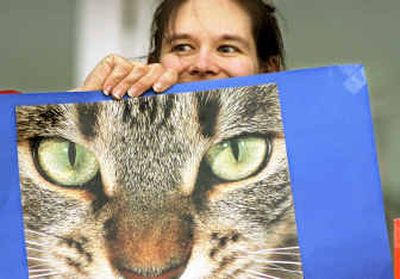Wisconsin ponders species classification for feral cats

CHICAGO – The fate of feral cats remained uncertain Tuesday in Wisconsin, where tallies show a narrow majority of those who attended statewide conservation hearings back the idea of allowing hunters, farmers and others to shoot stray cats without collars as a way to control their numbers.
The proposal passed 6,830 to 5,201 in an advisory vote taken in each of the state’s 72 counties Monday evening, with the measure generally finding support in rural areas and opposition in urban ones, according to the Wisconsin Department of Natural Resources.
In La Crosse County, where a firefighter who made the proposal later received death threats, it passed 146 to 75. DNR officials said more than 13,000 people attended the hearings statewide, more than twice as many as in a typical year.
The vote and related hearings generated heated emotions, including some cat lovers who wore fake ears and whiskers and carried photos of their pets. The measure asked whether the wild cats, estimated at a million-plus in Wisconsin, should be classified as an unprotected species.
Still, legally shooting a feral cat remains a long way off, with approval also needed by the state Conservation Congress, state Natural Resources Board and Wisconsin lawmakers – challenging political hurdles that likely would take a year or more.
“They have won the day, but they haven’t won the final fight,” said Ted O’Donnell, a Madison pet store owner who has helped lead opposition to the proposal. “We will keep fighting it at every step of the way.”
Wisconsin lawmakers have generally steered clear of the issue. Sen. Scott Fitzgerald, co-chairman of the Legislature’s powerful Joint Finance Committee, said Tuesday that he will “work against any proposed legislation to legalize the shooting of feral cats.”
Representatives from the Wisconsin Humane Society, which opposes the proposal, have said the West Nile virus and loss of habitat to development are far greater threats to birds than feral cats. The group supports trapping the cats, neutering them and returning them to the wild as one way to control their population.
“We’re obviously disappointed,” said Victoria Wellens, the group’s executive director. “We believe that shooting cats is an inhumane response to a problem we all agree needs to be addressed.”
A feral cat is typically defined as one with no identification collar that fails to show friendly behavior. Wildlife officials say studies suggest the felines kill millions of songbirds in Wisconsin each year. If shooting the cats is eventually approved, a small-game license might be needed to kill them, depending on whether policy-makers deemed them wild animals or a public nuisance.
Steve Oestreicher, chairman of the state’s Conservation Congress, said the next step comes on May 13, when the 360 delegates expected to attend the group’s annual meeting will vote on the proposal. He said the advisory group to the state Department of Natural Resources typically follows the vote taken at the county hearings.
“If the statewide vote is upheld (by the congress), then we would recommend that the Wisconsin DNR and the Legislature seek further input on it,” Oestreicher said.
Not since a highly emotional debate in 1999 and 2000 over the creation of a hunting season for mourning doves has there been so much controversy over the killing animals in Wisconsin, a place where outdoor traditions run deep. Horrified feline lovers had attempted to mobilize cat owners to attend the annual conservation hearings, gatherings that have traditionally been dominated by hunters and outdoors enthusiasts.
Although shooting a cat in Wisconsin is technically illegal, hunters and farmers routinely kill them in rural areas. Some view it as a way to protect game birds and other small animals that the cats hunt and kill.
Although the DNR has not studied the issue, a scientific basis often cited in the debate comes from a University of Wisconsin professor who estimated in 1996 that there were 1.4 million free-range cats in the state, responsible for at least 7.8 million annual bird deaths.
“There is a need for more objective information about cats,” said Wellens of the Wisconsin Humane Society.